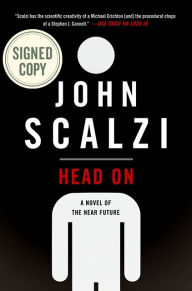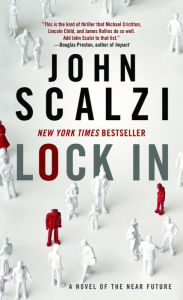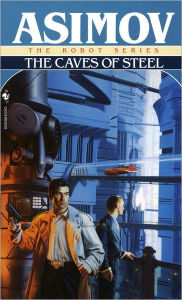Head On Is a Fascinating Future Mystery in the Tradition of Asimov
 Reading Head On gave me déjà vu, in a good way. Hugo-winner (and 2018 Hugo nominee) John Scalzi’s latest novel is a compelling combination of science fiction and police procedural, and it brings to mind my favorite of Isaac Asimov’s books: his science fiction mysteries.
Reading Head On gave me déjà vu, in a good way. Hugo-winner (and 2018 Hugo nominee) John Scalzi’s latest novel is a compelling combination of science fiction and police procedural, and it brings to mind my favorite of Isaac Asimov’s books: his science fiction mysteries.
Head On (Signed Book)
Head On (Signed Book)
By John Scalzi
Hardcover $25.99
This might strike you as funny, if you are aware of criticism the author has received in certain circles of the science fiction community for shifting the genre’s focus away from the sensawunda of “classic SF.” It’s odd: every one of his novels, including this one, reads to me like a love letter to old-school science fiction. Old Man’s War owes a great deal to Robert Heinlein. Redshirts is a post-modern take on Star Trek. Head On, the second future mystery novel featuring FBI agents Chris Shane and Lesley Vann, is reminiscent of Asimov’s Lije Bailey/R. Daneel Olivaw trilogy (The Caves of Steel, The Naked Sun, and The Robots of Dawn).
This might strike you as funny, if you are aware of criticism the author has received in certain circles of the science fiction community for shifting the genre’s focus away from the sensawunda of “classic SF.” It’s odd: every one of his novels, including this one, reads to me like a love letter to old-school science fiction. Old Man’s War owes a great deal to Robert Heinlein. Redshirts is a post-modern take on Star Trek. Head On, the second future mystery novel featuring FBI agents Chris Shane and Lesley Vann, is reminiscent of Asimov’s Lije Bailey/R. Daneel Olivaw trilogy (The Caves of Steel, The Naked Sun, and The Robots of Dawn).
That is not to say Scalzi is trying to simply imitate the greats. This novel stands on its own as a terrific mystery taking place is a fascinating near-future world. (It also improves on Asimov’s characterization, which was sometimes paper-thin in the service of the Grand Master’s concepts; his women tended to be particularly two-dimensional.)
The Bailey/Olivaw stories used mystery plots to explore high-concept questions: how would people react to living in cramped quarters on an over-populated Earth? How might human interaction change in a setting where all of it took place in the virtual realm?
Similarly, Scalzi has crafted a science-fictional police procedurals around an examination of the ways technology might change the way society functions, for better or worse.
Head On is set in a near-future world in which a disease known as Haden’s Syndrome has cut a swath through the population, killing many, and reducing the physical bodies of the survivors to a vegetative states, but their minds still sharp and aware. A major government push, led by a president whose wife suffered from Haden’s, resulted in a few major changes, instituted globally: one, robot bodies, called threeps (after C-3PO), were put into service to allow Haden’s sufferers to walk in the world. Two, a virtual world was programmed in order to give “locked-in” patients a place of their own creation in which to exist. The afflicted are thus well-integrated into the world, despite their condition—FBI Agent Chris Shane, one of our main characters, is a Haden’s patient.
Lock In
Lock In
By John Scalzi
In Stock Online
Paperback $11.99
The mystery of Chris and Vann’s second adventure surrounds a game called Hiketa, played by threeps piloted remotely, mostly by Haden’s patients. It’s a brutal sport in which a computer randomly chooses a player to lose his head. The opposing team, having taken the head, scores points by tossing it through a goal. The story opens with a game in which a player virtually loses his head three times, and then loses his life for real. (If you haven’t read the first novel, Lock In, this sequence also serves as an excellent introduction to the world; the prose is crisp and clear, and lays out all the information you’ll need to follow the story—and ably describes a thrilling make-believe future spot in the process.)
The mystery of Chris and Vann’s second adventure surrounds a game called Hiketa, played by threeps piloted remotely, mostly by Haden’s patients. It’s a brutal sport in which a computer randomly chooses a player to lose his head. The opposing team, having taken the head, scores points by tossing it through a goal. The story opens with a game in which a player virtually loses his head three times, and then loses his life for real. (If you haven’t read the first novel, Lock In, this sequence also serves as an excellent introduction to the world; the prose is crisp and clear, and lays out all the information you’ll need to follow the story—and ably describes a thrilling make-believe future spot in the process.)
While the mystery hinges upon technology, the human detectives are the ones who must sort out the motives for the murder, which are based old-fashioned human emotion. Vann and Chris interview the victim’s angry wife and their lover (yes, it’s possible for someone with Haden’s to be unfaithful), and a slew of sports league officials who may or may not bear resemblance to shady operators in the real wide world of sports. It’s a fun environment for investigative work—I loved how Chris’s ability to leap from one threep to another helps move the story along, as well as our visits to the virtual world of the Haden’s patients. Moments of levity are a given in Scalzi’s work, and he mines a lot of humor out of a rivalry between competing FBI offices in Philadelphia and D.C. And there are touching moments as well; I’m thinking of a beautiful scene of Chris at home with the parents who have been so supportive, as Chris’s mother cuts her child’s hair. It shines a spotlight on Chris’s unique way of being, presenting the disease as a facet of a character, not the definition of one.
The Caves of Steel
The Caves of Steel
By Isaac Asimov
In Stock Online
Paperback $9.99
This is another Scalzi novel that takes pains to depict an inclusive future. Consider Chris’s character: once the children’s poster child for the disease that changed the world, Chris’s wry sense of humor carries the story, but their gender is never specified—nor was it in the first book—allowing for different readers to experience the novel in different ways. Vann is Chris’s older partner, a veteran agent who’s seemingly seen it all; she carries her cynicism with her, and has a perhaps more realistic understanding of people than her more idealistic partner.
This is another Scalzi novel that takes pains to depict an inclusive future. Consider Chris’s character: once the children’s poster child for the disease that changed the world, Chris’s wry sense of humor carries the story, but their gender is never specified—nor was it in the first book—allowing for different readers to experience the novel in different ways. Vann is Chris’s older partner, a veteran agent who’s seemingly seen it all; she carries her cynicism with her, and has a perhaps more realistic understanding of people than her more idealistic partner.
Like any satisfying mystery novel, this one is self-contained, and the solution is most satisfactory. Still, this is a cast and a world I hope Scalzi revisits again and again.
Head On is available April 17 in a signed edition from Barnes & Noble.


